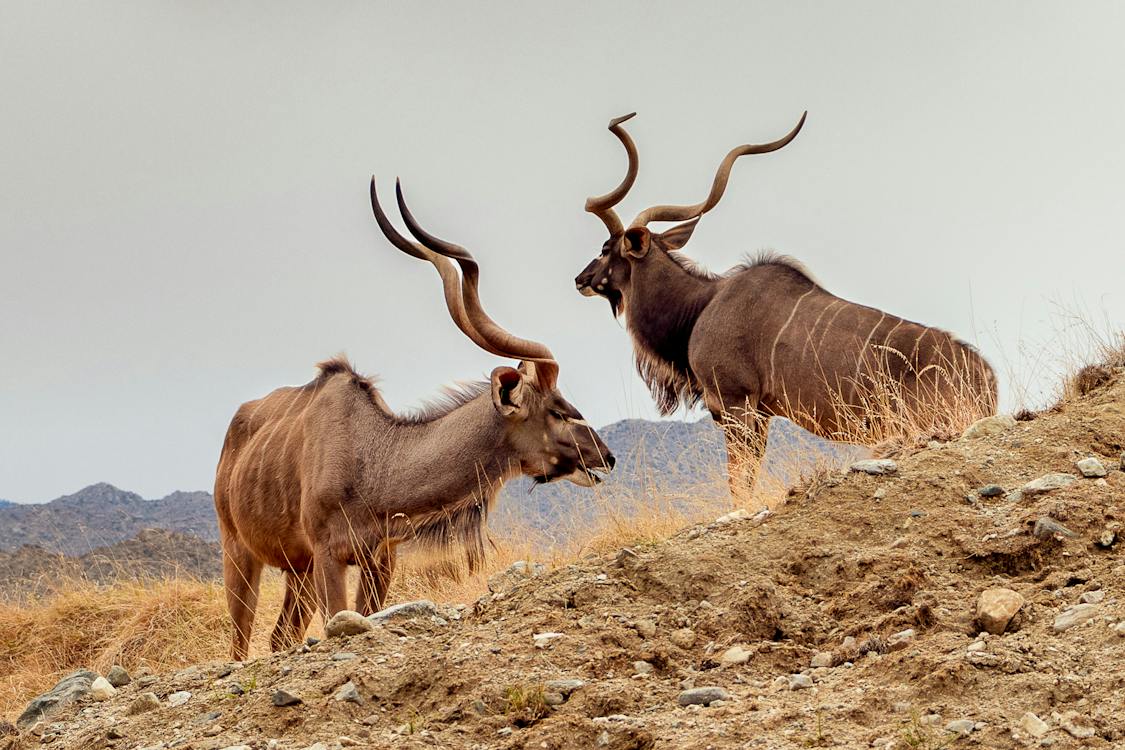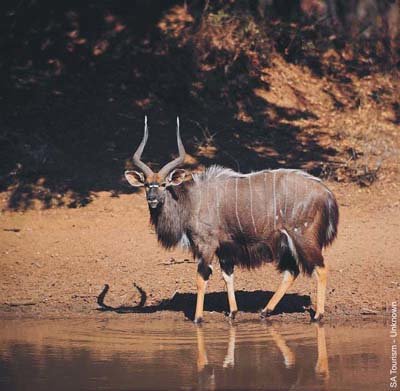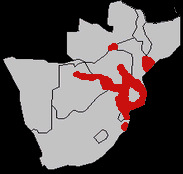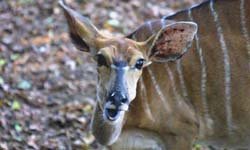SIZE: Shoulder height (m) 1,1 m, (f) 0,95 m; mass (m) 108 kg, (f) 62 kg.
COLOUR: Males shaggy, grey-brown coat; white chevron between eyes; up to 14 faint, narrow vertical stripes on sides. Mane of long, whitish hair from shoulders to rump; bushy tail brown, with a white underside. Lower parts of legs light orange. Females bright orange-brown, with bolder white stripes on their sides; often no chevron, narrow mane of short, bristly black hair from head to tail.
GESTATION PERIOD: 6 months
POTENTIAL LONGEVITY: 8 years
RECORD LENGTH OF HORNS: 83 cm
MOST LIKE: Males are similar to young Kudu bulls, which, however, lack the pronounced chest fringe, the fringe of long hair on belly, the ivory-coloured tips to the horns and the yellow orange 'socks' on legs. Females unmistakable with orange coat and vertical white stripes.
HABITAT: Dense bush close to water but, where protected, may be seen by day in the open.
Although usually silent, they sometimes communicate with some very distinctive sounds: females, for instance, utter a throaty clicking sound when tending their calves; a ram, acting sentry, will let out a resonant, warning bark when danger threatens, sending the rest of the herd fleeing for safety; a calf, separated from its mother, will bleat pitifully. Nyala are mixed grazer-browsers, and eat leaves, twigs, flowers and fruits from a wide variety of plants, as well as grass, particularly after rain. In spite of the fact that baboons have been known to eat nyala young, nyala often associate with them, picking up the remains of wild fruit, berries and leaves discarded by the baboons on foraging expeditions.
Older rams can often be seen browsing among herds of other antelope, especially impala. A single calf is born, usually in the cover of a thicket. The calf hides in the grass for about 18 days, after which it joins the herd.
Their name originates from the Zulu name inxala. Female nyala are a characteristic rusty red, with white stripes down their sides. Nyala are gregarious, and are normally found in small groups of two or three, although they sometimes form herds of up to 30: these herds are transient in nature, and no lasting bonds are formed.
Often these larger groupings are formed due to preferred feeding grounds: in addition, it is characteristic of bovids that normally frequent cover to form larger groups when on open ground, as this provides greater protection from predators. They are not territorial, and occupy overlapping home ranges.
WILDLIFE PARKS AND RESERVES WHERE THIS SPECIES IS FOUND:
BOTSWANA
Okavango Delta
Moremi Game Reserve
ZAMBIA
Lower Zambezi
ZIMBABWE
Gona-re-Zhou
Mana Pools
Matobo Hills




